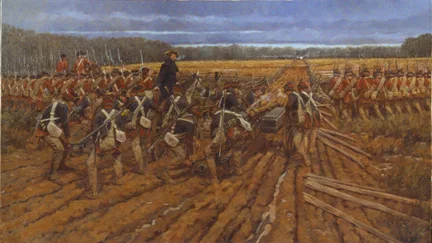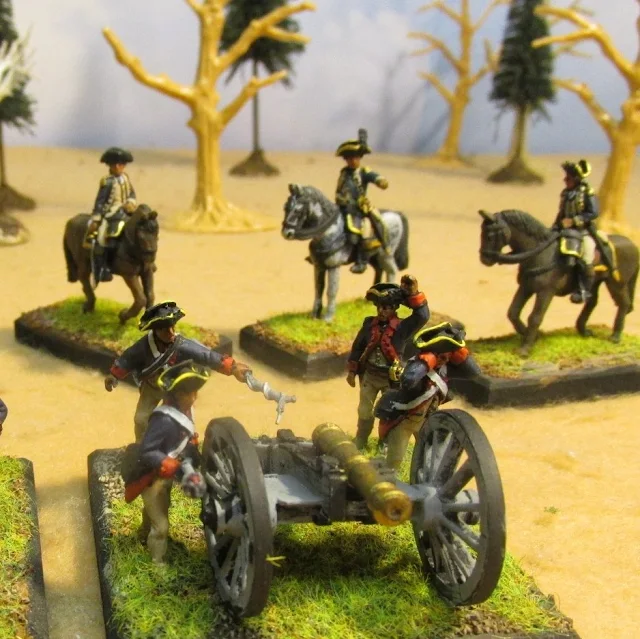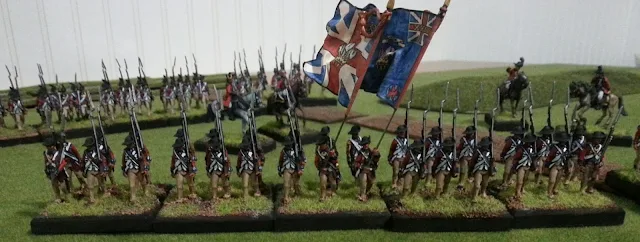In volume one issue one of The Courier Steve Haller wrote an article about wargaming campaigns without maps. in this article he refought the Cowpens -Guildford Courthouse campaign using this method. Always a big fan of his writing in the Courier, I recently revisited his article with a mind to use his suggested campaign.
In his introduction Haller wrote, "War gamers who enjoy the variety that acampaign offers for the use of their collections are often discouraged by the time and clutter involved when maps are used. An alternative method might employ the use of an scenario based on a historical campaign (complete with OB's, etc) which allows elements of choice and chance to determine the nature of each battle of the campaign. Each battle is assigned a number of points that are awarded based on the results of the Battle (e.g. comparison of casualty ratios). " To me this has always been a fascinating idea which I wanted to try out. Taking Steve Haller's article and work I have slightly modified it by changing some of the options for battles and created my own order of battles based on historical returns. But the spirit of the campaign remained what Steve wrote way back in the early 1980's. Here is my outline and rules for the Cowpens -Guilford Courthouse Campaign. The campaign order of battle including militia desertion (i.e. going home) and reinforcements will be in the next post as part 2.
Campaign Guide Lines:
1. Rules used are Loose Files and American Scramble.
2. Figure scale is 10:1
3. Terrain to be based on historical battles in the area.
4. After each battle 25% of casualties will be returned to each unit. One month after that battle all American units (including loyalists) receive an additional 25% returned. Two months after battle British and Hessian units receive back 25% casualties. Units that drop to under 20% of their original strength after a battle are eliminated.
5. Staff Officers return after battle if roll a 4-6 on a D6.
6. Players should be familiar with the historical campaign.
THE CAMPAIGN:
1. January 1781
General Morgan invades South Carolina with his Light Troops. He can successfully link up with Pickens' South Carolina brigade by rolling 1-4 on a D6; Sumter's brigade will join on a roll of 1-3.
Morgan now has three options:
1. Fight Cowpens as the historical battle with historical order of battle.
2. Attack Camden. The garrison under Rawden will march out to fight him at the Hobkirk Hill area. After that battle Tarleton will try to intercept Morgan by rolling a 1-3 for an encounter battle.
3. Attack the Fort Ninety-Six garrison. A defense will be set up by Cruger based on a Steve Haller scenario. The garrison can be reinforced by Tarleton by rolling 1-4 on a turn determined by a die roll.
2. February 1781
Cornwallis' and Tarleton chase Greene's and Morgan's forces through North Carolina. The following battles are possible and determined by a die roll:
1. Cowen's Ford will be defended by Davidson's militia brigade as the historical battle by rolling 1-4. Greene can detach elements of the Continental Light Division to assist on a turn determined by a die roll.
2. A meeting engagement on random terrain involving all units if a 5-6 is rolled.
March 1781
Greene's reinforced army turns to fight Cornwallis army.
1. Guilford Courthouse as the historical battle by rolling 1-4.
2. Greene attacks Cornwallis army at Guilford Courthouse by rolling 5-6.
Victory is determined by casualties and condition of army at end of campaign. Forces available for certain battles or each month will be posted in addition order of battles.
I am presently finishing the last couple of regiments for this campaign. Once done I will be reporting the progress of how this turns out. I am looking to set this up for June 2017.





















































